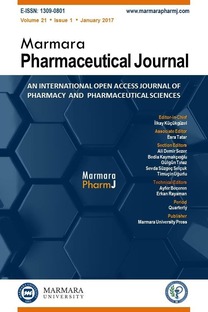Diclofop-methyl: A phenoxy propionate herbicide with multiple toxic effects in mouse embyro fibroblast (NIH/3T3) cell line
Diclofop-methyl: A phenoxy propionate herbicide with multiple toxic effects in mouse embyro fibroblast (NIH/3T3) cell line
___
- Cañas N, Valero T, Villarroya M, Montell E. Chondroitin sulfate protects SH-SY5Y cells from oxidative stress by inducing heme oxygenase-1 via phosphatidylinositol 3-kinase/ Akt. J Pharmacol Exp Ther 2007; 323: 946–53.
- Department of National Health and Welfare. Unpublished studies; summary of evaluations by the Food Directorate (1988).
- Bolognesi C, Morasso G. Genotoxicity of pesticides: potential risk for consumers. Trends Food Sci Technol 2000; 11: 182–7.
- DiTomaso J, Brown P, Stowe A, Linscott D. Effects of diclofop and diclofop-methyl on methyl on membrane potentials in roots of intact oat, maize, and pea seedlings. Plant 1991; 95: 1063–9.
- Sandal S, Yilmaz B. Genotoxic effects of chlorpyrifos, cypermethrin, endosulfan and 2,4‐D on human peripheral lymphocytes cultured from smokers and nonsmokers. Environ Toxicol 2011; 26: 433-42.
- Collins AR. The comet assay for DNA damage and repair: principles, applications, and limitations. Mol Biotechnol 2004; 26: 249–61.
- Speit G, Hartmann A. The comet assay (Single-Cell Gel Test) a sensitive genotoxicity test for the detection of DNA damage and repair. DNA Repair Protoc Eukaryot Syst 1999; 203-12.
- Alpertunga B, Kara M, Abudayyak M. Effects of prochloraz on DNA damage, lipid peroxidation and antioxidant system in vitro. Toxicol Mech Methods 2014; 24: 268-75.
- Abudayyak M, Öztaş E, Arici M, Özhan G. Investigation of the toxicity of bismuth oxide oxide nanoparticles in various cell lines. Chemosphere 2017; 169: 117-23.
- Methods Analytical and Health Effects. Diclofop-Methyl 1987; (March 1987): 1–2.
- Meyer KJ, Reif JS, Rao Veeramachaneni DN, Luben TJ, Mosley BS, Nuckols JR. Agricultural pesticide use and hypospadias in Eastern Arkansas. Environ Health Perspect 2006; 114: 1589– 95.
- Eliyahu D, Applebaum S, Rafaeli A. Moth sex-pheromone biosynthesis is inhibited by the herbicide diclofop. Pestic Biochem Physiol 2003; 77: 75–81.
- Ye J, Wang L, Zhang Z, Liu W. Enantioselective physiological effects of the herbicide diclofop on cyanobacterium Microcystis aeruginosa. Environ Sci 2013; 47: 3893–901.
- Ding H, Lu H, Lavoie M, Xie J, Li Y, Lv X. Unraveling the toxicity mechanisms of the herbicide diclofop-methyl in rice: modulation of the activity of key enzymes involved in citrate metabolism and induction of cell membrane anion channels. J Agric 2014; 62: 10654-60.
- United States Environmental Protection Agency (U.S. EPA). Prevention, pesticides and toxic substances. EPA738-F-00-007 (7508C) R.E.D. FACTS diclofop-methyl. Washington, DC; 2000.
- Hongming L, Xu L, Zhaojian G, Fan Y. Isolation of an aryloxyphenoxy propanoate (AOPP) herbicide-degrading strain Rhodococcus ruber JPL-2 and the cloning of a novel carboxylesterase gene (feh). Brazilian J 2015; 432: 425–32.
- Shimabukuro R, Hoffer B. Enantiomers of diclofop-methyl and their role in herbicide mechanism of action. Pestic Biochem Physiol 1995; 51: 66–82.
- Unal F, Yüzbaşıoğlu D, Yılmaz S, Akıncı N, Aksoy H. Genotoxic effects of chlorophenoxy herbicide diclofop-methyl in mice in vivo and in human lymphocytes in vitro. Drug Chem Toxicol 2011; 34: 390-5.
- Larsen K, Najle R, Lifschitz A, Mate ML, Lanusse C, Virkel GL. Effects of sublethal exposure to a glyphosate-based herbicide formulation on metabolic activities of different xenobioticmetabolizing enzymes in rats. Int J Toxicol 2014; 33: 307–18.
- Abd-alrahman SH, Elhalwagy MEA, Kotb GA, Farid H, Farag AAG, Draz HM, Isa AM, Sabico S . Exposure to difenoconazole, diclofop-methyl alone and combination alters oxidative stress and biochemical parameters in albino rats. Int J Clin Exp Med 2014; 7: 3637–46.
- ISSN: 1309-0801
- Yayın Aralığı: Yılda 6 Sayı
- Başlangıç: 1985
- Yayıncı: Marmara Üniversitesi
Gel permeation chromatographic method for drug protein binding studies
Manish BHATIA, Swapnil JADHAV, Santosh KUMBHAR
Revika RACHMANIAR, Camellia PANATARANI, I Made JONI, Marline ABDASAH, Taofik RUSDIANA
MEHMET ENGİN CELEP, ERDEM YEŞİLADA
LEYLA YURTTAŞ, KAAN KÜÇÜKOĞLU, HAYRUNNİSA NADAROĞLU, ZAFER ASIM KAPLANCIKLI
Synthesis and antibacterial activity of new hydrazide-hydrazones derived from Benzocaine
MUHAMMED İHSAN HAN, Güler GÜROL, Temel YILDIRIM, Sadık KALAYCI, FİKRETTİN ŞAHİN, Ş. Güniz KÜÇÜKGÜZEL
Prescribing pattern of antidiabetic drugs in type 2 diabetic patients of Noakhali city in Bangladesh
Anwesha CHOWDHURY, Niloy SEN, Sujan BANİK
In vitro gene silencing effect of chitosan/shRNA PDGF-D nanoparticles in breast cancer
CEYDA EKENTOK, Suna ÖZBAŞ TURAN, Jülide AKBUĞA
Preparation and characterization of herbal emulsion formulations
SAKİNE TUNCAY TANRIVERDİ, Evren Algın YAPAR
SEVDA GÜZEL, Roman PAVELA, AHMET İLÇİM, GAMZE KÖKDİL
Türkiye’de geleneksel halk ilacı olarak kullanılan ağrı kesici etkili bitkiler-I MİDE AĞRISI
